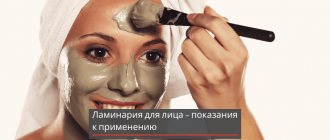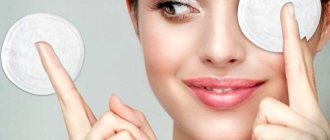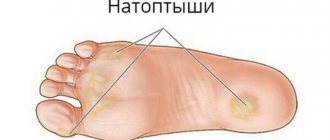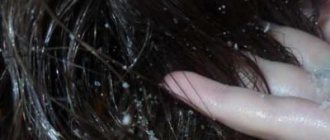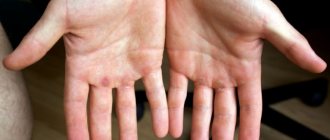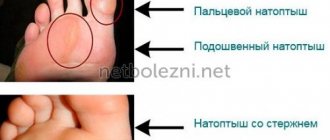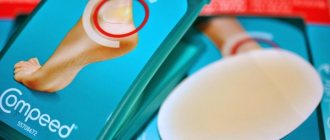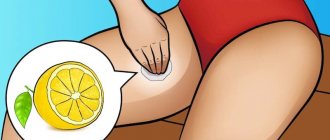The article was prepared by a specialist for informational purposes only. We urge you not to self-medicate. When the first symptoms appear, consult a doctor.
The best remedies for corns:
- Salicylic acid
- Celandine for corns
- Soda
- Onion for corns
- Apple vinegar
- Essential oils
- Castor oil
- Foot bath
- Glycerin with vinegar
- Baths for corns
- Other folk recipes
Salicylic acid for corns
It is no coincidence that salicylic acid is the basis of many keratolytic agents. This is due to its healing properties: the ability to soften the skin and exfoliate dead cells from its surface. By acting on the corns, it helps to painlessly remove them with a pumice stone or brush. In the pharmacy you can find salicylic acid, presented in the form of a solution, ointments and even patches.
This product should be used with caution. Excess salicylic acid can cause a burn. Therefore, it must be applied strictly to the callus, without affecting the healthy skin around it. Salicylic patches are convenient in such cases. It is easy to cut out a piece of the desired shape from them, thus avoiding burns to the skin around the corns.
You can treat the callus with a salicylic acid solution several times a day. If an ointment is used for treatment, a bandage is soaked in salicylic acid and then applied to the foot. It is also convenient to use a sterile napkin in such cases.
When used correctly, salicylic acid rarely causes irritation or itching. However, if such a reaction occurs, treatment should be stopped immediately.
How to remove corns using pharmaceutical products
Pharmaceutical products include creams, ointments, and adhesive plasters. These products include salicylic acid, which has keratolytic (softening) and anti-inflammatory properties, and also helps exfoliate dead skin cells.
Before using such a product, you should make a steaming foot bath in order to enhance the desired result.
You should buy the necessary products at the pharmacy, then apply a generous layer only to the affected part of the foot, without touching healthy skin. The applied product should be covered with an adhesive plaster for several hours, or better yet, overnight.
After removing the adhesive plaster, the softened corns can be easily removed with a rough pumice stone. If necessary, the procedure should be repeated.
Celandine for corns
Celandine is a widespread plant that is used in the treatment of many diseases. Its stems and leaves are bright green, its flowers are yellow. You can distinguish celandine from other herbs by its orange milky juice. You should look for this plant in shady places.
Celandine is used in both folk and traditional medicine due to its bactericidal, anti-inflammatory and antispasmodic properties. With its help you can relieve pain, get rid of inflammation on the skin, and cleanse it.
Celandine is harvested during the flowering period, carefully drying the stems and leaves. Such raw materials can be used for preparing medicinal tinctures for 3 years. However, to remove corns, take fresh celandine. Its leaves and stems should be thoroughly chopped. You need to act carefully: celandine juice is difficult to wash off from things. Apply the resulting paste to the place of the callus, cover with foil on top and put on socks. This compress can be done at night for a week. In the morning, the corns should be treated with a pumice stone or a brush.
Despite its medicinal properties, celandine is useful in moderate doses. Its juice can cause severe poisoning, nausea, vomiting and headaches. Therefore, you need to use celandine carefully, carefully observing the body’s reaction to it.
Cryodestruction
Liquid nitrogen is used in medicine to remove warts, scars and corns. Among all the methods to get rid of dry calluses, cryodestruction or cryotherapy is considered the most painful. After it, the skin takes a long time to recover and requires careful care. In addition, removing corns with liquid nitrogen is an expensive procedure.
However, despite all the disadvantages, cryotherapy also has advantages. So, there is no blood involved, and it takes very little time, which is important for many. Self-treatment requires constant repetition of procedures; you need to carefully put on your shoes. After cryodestruction there are no traces or scars left. The risk that corns will form again in the same place is minimal. For those for whom anesthesia is contraindicated, this is a very successful option for surgical removal of dry calluses. The procedure does not require pain relief. Although because of this you will have to endure unpleasant sensations.
Liquid nitrogen has virtually no contraindications, but it can only be used on a small area of skin. If the corns are large or several calluses are located nearby, cryotherapy will not be suitable in this case. Recovery will be too long and difficult.
Soda for corns
One of the most effective and affordable means for removing dry calluses is baking soda. It is inexpensive and has many useful properties. Using soda, you can cleanse the body and remove heavy metals such as bismuth, cadmium, and mercury. This remedy is used to prevent cancer, treat rheumatism, radiculitis, and osteochondrosis. Baking soda softens the skin well, so it is also used to get rid of corns. To achieve better results, it is combined with other folk remedies.
First of all, baths help with corns. The feet must be kept in water with soda for half an hour. Usually dissolving a couple of tablespoons is enough. In addition to soda, you can add the same amount of crushed soap and ammonia.
Compresses are also quite effective in combating corns. A mixture of tomatoes and soda should be left for 15 minutes and applied to the place of calluses, covering with film on top. Typically, such procedures can get rid of corns in a few weeks. Instead of tomatoes, you can take onions, grated or finely chopped with a knife. The mixture must be kept for at least 8 hours.
A useful remedy for corns is obtained from soda and prunes. Dried fruits need to be cooked until they become soft. Then the prunes are crushed and mixed with soda. As in the previous case, a warm compress is applied for several hours.
Effective methods for treating corns
Treatment of corns at home or in beauty salons should begin as soon as you notice this problem. First, you need to eliminate the cause that provoked the appearance of dry calluses and take preventive measures.
You can remove corns using the following methods:
- Softening the epidermis and removing the dead layer with special files or pumice;
- Hardware pedicure (including at home);
- Medications;
- Traditional medicine.
Each of the listed methods of combating corns is effective, but it is selected individually depending on the degree of compaction and sensitivity of the skin.
You may be interested in: “Gel polish at home: a step-by-step guide for beginners”
Steaming and removing corns with pumice
To remove nails at home, you can use the simplest and most accessible method, such as steaming your feet in warm water with the addition of special products and further removing the coarsened particles with a nail file or pumice stone.
If the corns are at the initial stage of formation, then it is very easy to cure. To do this, just soften the skin in regular warm water. If the compaction is rough, then you can use a keratolytic agent, which, in addition to the softening effect, also acts as a kind of antiseptic. During the process of removing the keratinized area, no pain should be felt. Otherwise, you need to immediately stop the procedure and continue steaming. The seal should peel off painlessly and freely.
The ointment and cream are applied to the keratinized area of skin overnight, after which it is sealed with a band-aid. In the morning, the feet are washed well in warm water and the softened layer of the epidermis is easily removed using pumice, a metal foot grater or stiff bristles. You cannot use a razor as a tool for cleaning heels, as sharp blades can injure the skin and create serious problems for a woman. After finishing the bath, it is recommended to wipe your feet dry with a towel and apply foot cream with softening ingredients using massaging movements. This procedure should be performed until the rough growth disappears.
If you repeat this procedure once a week, your heels will always look perfect, and there will be no trace of corns left.
You may be interested in: “What are hair fillers: a review of the best products”
Hardware pedicure at home
You can get a hardware pedicure either in a beauty salon or at home, the most important thing here is the presence of a special device. Before carrying out a procedure aimed at removing corns, you should first soften the skin in the problem area; to do this, you need to steam your feet in warm water. The advantages of using pedicure devices are that the kit already includes several replaceable attachments that differ in surface granularity. Regular procedure will allow you to quickly and permanently get rid of corns. After the procedure, you need to apply a nourishing or moisturizing cream to your feet.
When performing a hardware pedicure at home, you should use antiseptics to prevent infection from getting into the treated area.
If you do not have the opportunity to regularly visit beauty salons, then it is quite possible to purchase a compact pedicure device that is intended for home use. Preference should be given to well-known brands and trusted manufacturers who have long established a reputation in the consumer market. Otherwise, you can purchase a fake copy, which will be inferior in quality, and the service life of such a device will be short.
Many people are interested in the question: is it possible to cut off corns on the feet? Experts categorically prohibit doing this, since it can damage the healthy epidermis, causing unbearable pain.
Medications
At the pharmacy you can buy many different remedies for corns, and at fairly affordable prices.
Before visiting the pharmacy, you must consult a doctor who will conduct a visual examination and be able to prescribe adequate and effective treatment.
If you do not have the time or opportunity to see a doctor, you can contact a pharmacy worker - a pharmacist or pharmacist. A pharmacy worker will tell you about the advantages or disadvantages of a particular product and provide you with professional advice on all products, and will tell you which drugs can be used to get rid of corns at home. And the decision will be yours.
Ointments and creams for corns
Pharmacies offer a wide range of products aimed at combating rough areas of the skin. Most often, buyers give preference to easy-to-use products, ointments and creams, the use of which does not require special skills or special knowledge. To get rid of corns at home using external means, it is important to know that you only need to treat the area where there is a seal, and the area around the dry callus needs to be lubricated with Vaseline.
The most famous external remedies (ointments and creams) are:
- Salicylic ointment - contains salicylic acid. Salicylic ointment for corns helps eliminate the problem quickly and effectively at home. To eliminate calluses, use 10% ointment, which is applied under a bandage or napkin. The duration of treatment is from 1 to 3 weeks. Topical application of salicylic acid provides bactericidal and keratolytic effects. The active component appears in the bloodstream in negligible quantities and has no effect on the body.
- Bensalitin is a combined drug (salicylic and benzoic acids) for external use, has a keratolytic, local irritant and antiseptic effect. High keratophilicity and accumulation in the stratum corneum of the skin ensure the effectiveness of the drug. Before using to remove calluses, you should take a warm foot bath; the skin around the callus should be protected by smearing it with Vaseline or sticking an adhesive plaster. Ointment is applied to the callus and covered with a second layer of plaster. After a few hours, remove the ointment and patches. Apply until the callus softens.
- Super Antimozolin cream - the cream contains urea, lactic and salicylic acids. These cream components moisturize and soften dry calluses. With regular use of the cream, hard protein formations of the skin and callous thickenings gradually dissolve. The cream has a bactericidal effect, as it contains extracts of eucalyptus and aspen. Ideally softens corns, which allows you to get your feet in order in the shortest possible time.
- Cream Doctor - the main active ingredient of the cream is urea. Urea is a moisturizer; it helps tissues replenish the lack of moisture, softens rough skin, exfoliates dead cells, and promotes the healing of small cracks and wounds. It is a good analgesic, that is, it relieves pain. The cream also contains: oak bark, celandine extract, tea tree oil, vitamin E. The Healer cream is effective not only for the treatment of corns, it is excellent for the treatment of dry calluses and cracked heels. The cream is also used to soften dry skin of the legs, flaking, and also to relieve fatigue and heaviness in the legs.
- Avon corns cream is one of the cosmetics company’s products, the use of which has a softening effect on the seal.
- Nemozol cream is intended for the care of rough skin of the feet and toes. It has an antiseptic, fungicidal and keratolytic effect due to its components (salicylic acid, sulfur) and helps soften and separate calluses. Sulfur helps prevent fungal diseases and helps with various skin injuries - wounds, scratches, abrasions.
- Aquapeeling cream - quickly softens and moisturizes the skin, effectively removes dead skin cells and starts natural regeneration processes. Softens, moisturizes and nourishes the skin. Aqua peeling is used for corns, dry calluses and cracked feet. With regular use of the cream, you can get perfectly smooth heels, just like after a salon pedicure.
- Wartner appticator pen - designed to remove dry calluses that form as a result of constant pressure on the skin, for example, as a result of wearing tight shoes. It contains a special thick TCA gel. TCA gel has a pronounced keratolytic effect and causes gradual peeling of dry callus, in its place new healthy skin is formed. Before use, consultation with a specialist is required.
- Keratolic Gel penetrates deeply into rough skin and softens calluses in just a few minutes. While destroying calluses, the gel does not injure living cells of the epidermis. First you need to prepare your feet (steam). Then apply the gel to your feet and leave it on (5 to 15 minutes). Remains of the gel should be removed with a napkin. After using the drug, you only need to lightly sand the skin. Do not use the gel to treat feet with open wounds.
- Radevit is a combined dermatoprotective ointment for topical use. It has anti-inflammatory, softening, moisturizing, reparative and antipruritic effects, normalizes keratinization processes, and enhances the protective function of the skin. It is used in the presence of wounds, cracks, ulcers. Apply a thin layer 2 times a day.
- D-panthenol ointment stimulates skin regeneration, normalizes cellular metabolism, accelerates mitosis and increases the strength of collagen fibers. It has a regenerating, metabolic and mild anti-inflammatory effect, eliminates dryness. The ointment contains dexpanthenol (a derivative of pantothenic acid), and also contains almond oil. The ointment is suitable for daily use.
Patches for dry calluses
A complete replacement for the listed pharmaceutical products is a special medicinal patch for corns and calluses, which can easily be used at home. To get rid of the seal, just stick on a piece of adhesive tape of a suitable size and leave it overnight. In the process of using such a patch, the healthy epidermis is not damaged, and the corns gradually disappear layer by layer. It is only necessary to additionally remove rough skin with pumice. You can get your feet in order using the patch in 3-7 days. The most popular of them are corn adhesive plaster, compeed, salipod .
Pedicure socks
It is possible to get rid of corns at home with the help of special pedicure socks, thanks to which the rough areas on the feet are softened and removed quite easily. The roughened epidermis will peel off on its own. The socks should be worn at night, and the first result will be noticeable after 2-3 days.
Traditional medicine
Many people have a tendency to allergic reactions or individual intolerance to the active substances of pharmaceutical products. Therefore, traditional medicine based on natural ingredients will help get rid of dry calluses at home.
- Medicinal herbs. Warm baths made from medicinal herbs for corns are perfect for softening the skin. Take oak bark, chamomile, calendula and string in equal proportions, pour boiling water and leave for 30 minutes. The infusion is poured into a basin, diluted with hot water so that the skin can tolerate it. Place your feet in the bath for 15 minutes.
- Salt. A salt bath (1/2 cup of table or sea salt per 1 liter of water and a small amount of liquid soap or soap shavings) not only softens the skin, but also promotes rapid healing. The components are mixed well, the legs are immersed in the saline solution for 15 minutes. After performing this procedure, the seal is removed with a pumice stone or file, and a moisturizer is applied to clean skin.
- Hydrogen peroxide. Hydrogen peroxide works well on dry calluses. To do this, it is enough to dissolve 3 tablespoons of peroxide in a bowl of warm water (if conditions permit). After such a bath, dead skin particles are easily removed, and the soles of the feet become smooth. The duration of the procedure is at least 60 minutes.
- Soda. Water treatments for feet are also performed using soda. A bath at home is done as follows: soda is diluted with water to a mushy state, applied to the feet and wrapped in polyethylene on top, and cotton socks are put on. Or dissolve a little soda in warm water and the feet or finger should be kept in this solution for 30 minutes. Soda has a softening, antimicrobial and wound-healing effect.
- Bite. Apple cider vinegar quickly softens the epidermis. The effect is achieved due to the acidic environment of the product. Add 50 ml of apple cider vinegar to a bowl of warm water and soak your feet in the bath for 5 minutes. After which the feet are well treated with pumice. The procedure is carried out once a week.
- Starch. Starch bath - 30 g starch should be diluted in 1 liter of warm water. Lower your heels for 20 minutes. Then dry your feet and lubricate with nourishing cream. It is recommended to perform this procedure before going to bed.
- Celandine grass. Celandine grows almost everywhere. The fresh plant is crushed to a paste, and the resulting mass must be applied to problem areas of the epidermis overnight. Feet should be wrapped in plastic and socks should be worn. Remember, it is almost impossible to remove celandine stains. In the morning, the corns should be rubbed with a pumice stone or a special nail file.
- Aloe. Aloe is a medicinal home remedy for corns. An aloe leaf is cut in half, and each part is applied to the rough areas of the skin. For fixation, use an adhesive plaster or bandage. In the morning, the compress is removed, and the skin should be lightly rubbed with pumice until the resulting growth disappears.
- Oatmeal. Oatmeal - perfectly softens the skin and exfoliates the epidermis. You need to take 50 grams of oatmeal and cook it. Mix the resulting pulp with 5 tablespoons of olive oil, cool to a comfortable temperature. Place the oatmeal mixture in plastic bags, place your feet in them, tie them, and put socks on top. After 4 hours, the mixture can be washed off with warm water and problem areas treated with pumice.
Onion for corns
Onions are not only a healthy vegetable, but also a traditional medicine. It contains many useful substances and vitamins. Onions are used to prevent and treat colds and improve the functioning of the digestive system. It has a positive effect on hair and facial skin, so preparations based on it are used in cosmetology.
Onion compress helps with corns. There are several variations of its recipe:
- Keep half the onion in vinegar for a day. Then apply the soaked leaves to dry calluses twice a day;
- mix finely chopped onion with milk and lubricate the resulting mass on the corns;
- Leave the onion skins in vinegar for 2 weeks. Apply it to calluses at night.
You can use fresh onion juice. If you regularly lubricate the areas of rough skin with it, you will soon be able to forget about dry calluses. At night, it’s good to apply fresh onion rings or chop them and mix them with potatoes. From above you need to wrap your feet with film and put on socks.
Baked onions are also used to treat corns. A large fruit is cut in half and baked in the oven for at least 20 minutes. Then one half is boiled for 3 minutes in boiling water. This solution is used for the bath. A compress from the second half of the baked onion is applied to the steamed skin of the feet. It should be crushed. Keep the mixture for several hours.
Prevention
Although using the above folk methods, corns are guaranteed to be eliminated within a week, their appearance in the future is not excluded. To avoid this, it is important to follow a number of simple preventive measures:
- in case of hormonal disorders or vitamin deficiency, it is important to ensure the body receives useful substances - dietary supplements, vitamins, healthy nutrition;
- foot hygiene - daily washing of feet, treating areas where corns and calluses formed in the past with pumice;
- cosmetic creams with a moisturizing effect;
- eliminate excessive sweating - both with the help of special means, and simply by frequently changing socks regularly.
Finally, remember the importance of choosing shoes that are comfortable for your feet. In the case of a beautiful floor, you should think about completely abandoning hairpins. For flat feet and other types of foot deformities, special orthopedic insoles, silicone pads or heel protectors are suitable.
Apple cider vinegar for corns
Regular apple cider vinegar relieves pain from insect bites, relieves heat and temperature, and improves the appearance of hair. You can gargle with its solution when you have a cold. Compresses based on apple cider vinegar are a surefire remedy for corns. They are made according to different recipes depending on the location of the corns formation.
If a dry callus has formed on the sole, then you should prepare a mixture of apple cider vinegar, baking soda and sea salt. Apply the compress with a bandage or bandage at night, cover with foil on top and put on socks.
Dealing with corns on your fingers is more difficult. An effective remedy in this case would be a crust of black bread soaked in apple cider vinegar. It needs to be carefully applied to the callus. Put a bag on top and then warm socks. Vinegar can be infused with onions.
There is another option for a remedy for corns on the fingers. The chicken egg must be washed and left in apple cider vinegar with a concentration of 80% for 10 days. Soak a cotton pad in the resulting solution and use it as a night compress. This treatment takes a lot of time, but gives good results.
You can pour a few cloves of garlic in apple cider vinegar and leave for 2 weeks, and then use it as a compress. Regardless of which recipe is used, after the procedure the corns are carefully removed with a pumice stone.
Hardware pedicure
If self-treatment does not produce visible results within several weeks, you should contact a specialist. The most gentle method is hardware pedicure. Many ladies, who are not even concerned about the problem of corns, regularly do this procedure in the salon, because it is several hours of pleasure, and the result is smooth and soft feet.
To get rid of dry calluses, you should contact a hardware pedicure specialist. This method allows you to remove corns as deeply as possible. The device also drills out calluses with a rod. It is almost impossible to get rid of them on your own, especially in advanced cases. During the procedure there is no discomfort, much less pain.
First of all, the feet are treated with a disinfectant. Then the corns are cleaned off using a fine-grained and coarse-grained drill.
When performing a hardware pedicure, the possibility of infection is excluded. An experienced master always works with gloves. The result of the procedure depends on the device. Good models provide complete removal of corns. If you do a hardware pedicure regularly, then the problem of dry calluses will no longer affect your feet.
Essential oils for corns
With the help of essential oils you can do massages, baths and compresses for dry calluses. All of these remedies are equally effective in the fight against corns.
Massage using vegetable oil is a painless and pleasant way to get rid of dry calluses. To do this, the product must be warmed up and applied to the feet with gentle movements. Massage rough skin areas for at least 5 minutes. Then your feet should be washed thoroughly in warm water. Vegetable oil goes well with lemon. This mixture is also suitable for massage.
If you add 10 drops of lemongrass and 20 drops of marjoram, tea tree, and sage to 15 drops of oregano and citronella oil, you will get a very aromatic remedy. It should be rubbed into the skin of the feet.
You can enhance the effect of regular baths with the help of essential oils. Add a couple of drops of tea tree oil to water with salt, and lavender or rose oil to the soda solution. Keep your feet in the bath for no more than 15 minutes.
You can make special compresses with essential oils every day. A cotton pad soaked in a mixture of lemon, marjoram, and lavender oils must be applied to the corn for 10-15 minutes. This must be done carefully so as not to hurt healthy skin. The compress mixture can also consist of the following ingredients: a little lemon juice, 2 drops of tea tree oil and a clove of garlic.
List of modern remedies for corns
Contraindications
Despite the fact that this method of foot treatment is relatively safe, the procedure has contraindications:
- You should not steam your feet when your body temperature rises, for example, during illness. This may cause deterioration.
- Pregnant women are prohibited from warming their extremities. This can cause miscarriage or premature birth.
- During menstruation, foot baths can cause bleeding.
- An allergic reaction is a signal to cancel the procedure. If you have a severe allergy, consult a doctor immediately.
- In case of diabetes mellitus, treatment of corns should be supervised by a doctor.
In case of severe damage to the skin, it is necessary to consult a doctor and choose treatment tactics based on individual characteristics.
Every millimeter of our body needs care. Do not neglect procedures that improve the appearance and condition of your feet. Foot baths are a popular and proven way to relieve discomfort, so it can be safely used by both men and women. Be healthy!
Castor oil for corns
Castor oil is very viscous and viscous and has many beneficial properties. It is used to soften the skin and give it elasticity, accelerate hair growth and restore it. In cosmetology, castor oil is added to many preparations and used in the manufacture of face masks. It helps cope with wrinkles and aging skin.
Due to its softening effect, castor oil can also be used to get rid of corns. It needs to be warmed up and applied to the feet, wrapped in film, and put on socks. It is recommended to leave this compress overnight or keep it for several hours. In the morning, dry calluses are cleaned off with pumice.
Foot bath for corns
Before starting to treat rough skin with compresses, ointments or creams, they should be steamed. The feet are kept in hot water or herbal infusion, sometimes sour milk whey is used. But salt baths also help well in such cases. Take a tablespoon of salt per liter of cold water. Several procedures help relieve pain and soften the skin at the site of corns. You can take such a bath for half an hour. Gradually, dry calluses will disappear. The number of procedures required for complete recovery depends on the degree of neglect of the corns.
Reasons for appearance
Corns, or dry calluses, are small compactions of dead epidermal cells on the surface layer of the skin. Most often they appear on the heels, but can also form on the feet and toes. Such formations develop due to regular mechanical pressure on the skin of the feet. Main reasons:
- wearing uncomfortable shoes;
- obesity;
- hormonal imbalance;
- frequent physical activity;
- dermatological diseases;
- increased sweating;
- improper foot skin care.
Corns are not just a cosmetic problem. While walking, they cause severe discomfort, pain and burning. In addition, regular pressure on the skin leads to impaired blood circulation in this area, which increases keratinization of the dermis.
If corns appear constantly and persist for a long time, this is a reason to consult an orthopedist. This problem may be a sign of certain leg pathologies, such as flat feet.
Baths for corns on feet
Before you start treating dry calluses at home, you need to steam your feet. To do this, you should make baths. They soften the skin before using keratolytic preparations and folk remedies. However, baths are a good method to get rid of corns without using any creams or ointments. It is enough to keep your feet in warm water or infusion for half an hour, and then treat the rough areas of the skin with a pumice stone or a soft brush.
To completely remove dry calluses, you may need to do this procedure several times. Baths are an essential part of the prevention of corns. If you do them regularly, dry calluses will not form and the skin will remain soft and smooth.
To enhance the effect, you can add soda, soap, and sea salt to the bath water. The use of herbal infusion or solution of permanganic acid also has a good effect on the skin of the feet. A universal bath recipe for both the prevention and treatment of dry calluses: add 2 tablespoons of soda, crushed soap and ammonia to 2 liters of water. Other options are also possible.
For example, keep your feet in warm sour milk. It has a specific smell, but softens the skin well. You can use a herbal infusion of thuja, St. John's wort and calendula for a bath. The dry mixture is brewed with boiling water and infused. Before use, the cooled solution must be warmed up. It is recommended to do such baths within a week to achieve the best results.
Recommendations for foot care
Old calluses and corns need to be actively combated, because one episode of care will not be enough. Follow these simple recommendations to get rid of the problem forever:
- Choose a container that can accommodate two full feet. This will help the skin steam evenly.
- It is worth doing the procedures before bed.
- Before taking a bath, wash your feet well under running water to remove excess dirt.
- The water temperature should not exceed 50 °C. Cold water will not give the desired effect, and hot water can worsen the situation. Give preference to warm water (39-40 °C).
- To remove the stratum corneum from the feet, it is advisable to use a special brush or pumice stone. Make smooth movements so as not to injure the skin.
- Massage your feet and toes to improve blood circulation and improve the flow of substances to the dermis.
- You should temporarily avoid visiting a bathhouse or sauna when treating your feet.
- If you feel discomfort in the foot area during steaming, it is better to stop the procedure.
- You should use foot baths for varicose veins with caution.
- If you feel dizziness, weakness, nausea or pain, it is better to interrupt the procedure and consult a doctor.
- If you have rough areas not only on your feet, but also on your heels, then in this case we advise you to use a peeling or scrub. After these procedures, the skin softens and is easy to treat. Then apply cream or oil to deeply moisturize.
- For the best effect after baths, you need to wear cotton socks. Allow your feet to cool gradually.
- If you have severe damage, you may need serious remedies, which the doctor will prescribe after assessing the extent of damage to the dermis.
- Develop the habit of doing a contrast shower for your feet every day, especially after a hard day at work.
- Baths for prevention should be used 2 times a week.
- After steaming, do not go outside, beware of hypothermia.
- Avoid wearing tight shoes. It provokes the appearance of calluses and corns. Give preference to natural materials.
- Get a foot pedicure at least twice a month. Even in winter.
- When caring for your toenails, don't forget to treat your feet. They need attention.

